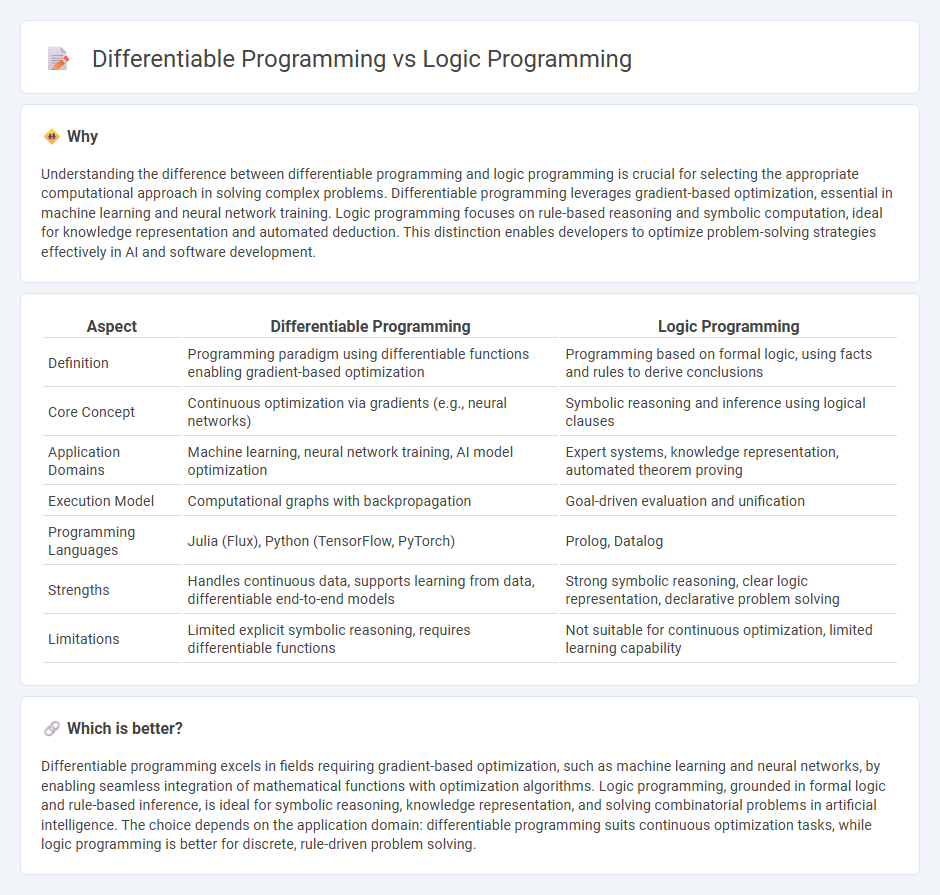
Differentiable programming leverages gradient-based optimization to enable neural networks and machine learning models to learn complex functions through continuous parameter adjustment. Logic programming, in contrast, relies on formal logic and symbolic reasoning to solve problems using declarative rules and logical inference. Explore the fundamental differences between these paradigms to understand their unique applications and advantages in technology.
Why it is important
Understanding the difference between differentiable programming and logic programming is crucial for selecting the appropriate computational approach in solving complex problems. Differentiable programming leverages gradient-based optimization, essential in machine learning and neural network training. Logic programming focuses on rule-based reasoning and symbolic computation, ideal for knowledge representation and automated deduction. This distinction enables developers to optimize problem-solving strategies effectively in AI and software development.
Comparison Table
| Aspect | Differentiable Programming | Logic Programming |
|---|---|---|
| Definition | Programming paradigm using differentiable functions enabling gradient-based optimization | Programming based on formal logic, using facts and rules to derive conclusions |
| Core Concept | Continuous optimization via gradients (e.g., neural networks) | Symbolic reasoning and inference using logical clauses |
| Application Domains | Machine learning, neural network training, AI model optimization | Expert systems, knowledge representation, automated theorem proving |
| Execution Model | Computational graphs with backpropagation | Goal-driven evaluation and unification |
| Programming Languages | Julia (Flux), Python (TensorFlow, PyTorch) | Prolog, Datalog |
| Strengths | Handles continuous data, supports learning from data, differentiable end-to-end models | Strong symbolic reasoning, clear logic representation, declarative problem solving |
| Limitations | Limited explicit symbolic reasoning, requires differentiable functions | Not suitable for continuous optimization, limited learning capability |
Which is better?
Differentiable programming excels in fields requiring gradient-based optimization, such as machine learning and neural networks, by enabling seamless integration of mathematical functions with optimization algorithms. Logic programming, grounded in formal logic and rule-based inference, is ideal for symbolic reasoning, knowledge representation, and solving combinatorial problems in artificial intelligence. The choice depends on the application domain: differentiable programming suits continuous optimization tasks, while logic programming is better for discrete, rule-driven problem solving.
Connection
Differentiable programming integrates gradient-based optimization techniques with traditional programming, enabling neural networks to learn complex behaviors. Logic programming focuses on symbolic reasoning through declarative rules and facts, facilitating problem-solving with explicit logic structures. Their connection lies in hybrid models where differentiable components enhance logic reasoning by allowing continuous optimization within symbolic frameworks, improving tasks like natural language understanding and knowledge representation.
Key Terms
Logic programming: Prolog, Rule-based inference, Unification
Logic programming, exemplified by Prolog, relies on rule-based inference to solve problems through formal logic and symbolic reasoning. Unification, a key mechanism, enables pattern matching by systematically binding variables to make logical expressions identical, facilitating automated theorem proving and query resolution. Explore how these foundational principles drive logic programming's applications in artificial intelligence and knowledge representation.
Differentiable programming: Automatic differentiation, Gradient descent, Neural networks
Differentiable programming leverages automatic differentiation to compute precise gradients, enabling efficient optimization through gradient descent algorithms. This approach is fundamental in training neural networks, where model parameters are iteratively adjusted to minimize loss functions. Explore how differentiable programming integrates with advanced machine learning techniques to enhance model performance.
**Logic Programming:**
Logic programming emphasizes symbolic reasoning through formal logic representations, enabling rule-based problem solving and automated inference. Key frameworks such as Prolog use facts and rules to model complex relationships and derive conclusions from given knowledge bases efficiently. Explore further to understand how logic programming's declarative nature contrasts with differentiable programming approaches.
Source and External Links
Logic programming - Logic programming is a paradigm based on formal logic where programs are sets of logical sentences, with computation performed by logical inference, commonly using languages like Prolog, Answer Set Programming, and Datalog.
Logic Programming Languages: Use Cases, Examples, and ... - Logic programming uses facts and rules to solve problems by deduction and backward reasoning, often exploring solutions through an and-or tree, and is frequently applied in AI and machine learning domains.
Logic Programming: What It Is and How to Use It - Logic programming expresses relationships and rules declaratively with facts and rules structured as logical predicates, enabling applications in natural language processing, database management, and predictive analysis.
 dowidth.com
dowidth.com